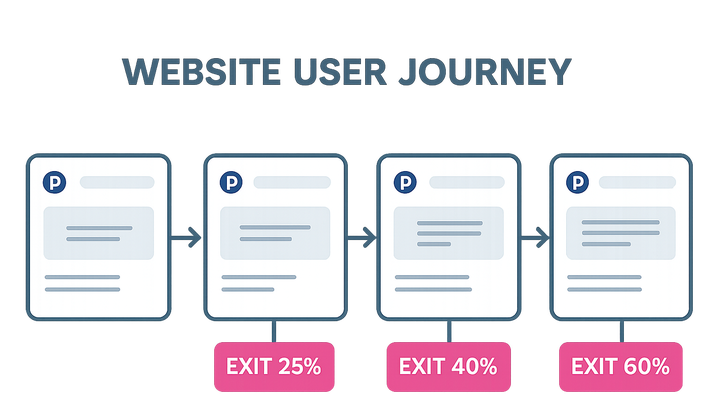Published on 2025-06-29T19:34:42Z
What is Exit Rate? Definition and Examples
Exit Rate is the percentage of user sessions that end on a specific page of your website out of the total pageviews for that page. It helps identify where visitors leave your site, which can highlight pages needing optimization for better conversion, improved user experience (UX), and SEO performance. High exit rates on key pages like product or signup pages can signal issues such as slow load times, unclear calls to action, or mismatched content. By monitoring exit rates in tools like Google Analytics and applying actionable insights from Prevue.me, you can pinpoint weak spots in your site journey and implement targeted improvements. Exit rate analysis complements metrics like bounce rate and session duration to give a fuller picture of user behavior and site effectiveness.
Exit rate
Percentage of visits ending on a page, showing where users leave your site.
Definition of Exit Rate
Exit rate measures the proportion of sessions that end on a given page relative to its total pageviews.
-
Core concept
Exit rate represents the share of user sessions concluding on a specific page, indicating where visitors abandon your site.
-
Formula
Exit Rate = (Exits from Page X / Total Pageviews of Page X) × 100 -
Practical example
If Page X has 1,000 views and 200 exits, its exit rate is 20%, meaning one in five sessions ends there.
Why Exit Rate Matters for CRO, UX, and SEO
Understanding exit rates helps optimize conversion funnels, improve user experience, and maintain SEO rankings by revealing where visitors disengage.
-
Conversion rate optimization (cro)
High exit rates on pages in a funnel lower overall conversions; reducing exits can boost lead generation and sales.
- Misplaced ctas:
Ensure calls-to-action are clearly visible and contextually relevant to keep users moving forward.
- Content gaps:
Fill informational holes that might cause users to leave in search of answers.
- Misplaced ctas:
-
User experience (ux)
Frequent exits can indicate frustration with navigation, layout, or page performance.
- Navigation issues:
Simplify menus and links so users can find what they need without leaving.
- Page speed:
Optimize images and code to reduce load times and prevent exit due to delays.
- Navigation issues:
-
Search engine optimization (seo)
Search engines may view high exit rates as a signal of low relevance or poor quality content.
- Relevant content:
Match page content to search intent to encourage deeper browsing.
- Internal linking:
Use strategic links to guide users to related pages instead of exiting.
- Relevant content:
Measuring Exit Rate
Track exit rates using analytics platforms and specialized UX/CRO tools to diagnose problem areas and monitor improvements.
-
Google analytics
Navigate to Behavior > Site Content > Exit Pages to see which pages have the highest exit rates.
- Segment analysis:
Compare exit rates by device, location, or traffic source for targeted insights.
- Time period comparison:
Monitor changes over time to assess the impact of optimizations.
- Segment analysis:
-
Prevue.me
Leverage prevue.me’s automated critiques to identify pages with high exit rates and receive tailored recommendations.
- Page-specific reports:
prevue.me highlights exit hotspots and suggests design, content, and CTA improvements.
- Lead generation focus:
Receive CRO-driven tips to refine forms, pop-ups, and messaging for better conversions.
- Page-specific reports:
Strategies to Reduce Exit Rate
Implement targeted tactics to keep visitors engaged, encourage further exploration, and improve conversion outcomes.
-
Optimize page load speed
Aim for load times under 2 seconds by compressing images, leveraging caching, and minifying code.
-
Enhance content relevance
Use clear headings, engaging visuals, and tailored messaging to meet user expectations.
-
Improve call-to-action clarity
Make CTAs prominent, action-oriented, and relevant to the page content.
-
A/b testing with prevue.me
Test different layouts, CTAs, and content variations to identify combinations that minimize exits.
- Cta text and color:
Experiment with wording and button colors to find the most compelling option.
- Page layout variations:
Compare single-column vs. multi-column designs for better flow and retention.
- Cta text and color:
